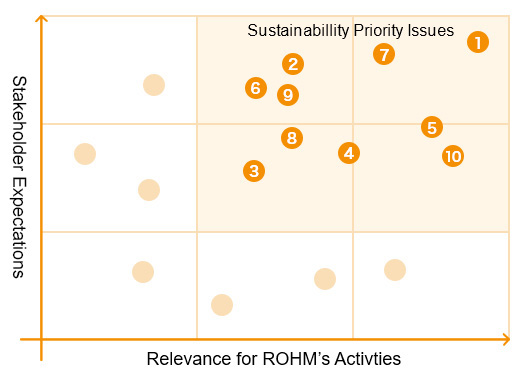Sustainability Priority IssuesROHM Group's Sustainability
Identifying Sustainability Priority Issues
Background of Re-identification of Sustainability Priority Issues
ROHM Group aims to solve environmental and social issues in the future and to be a company that continues to be chosen by stakeholders. In April 2021, we established the "ROHM Group Environmental Vision 2050" and declared our commitment to carbon neutrality and zero emissions.
In addition, we have re-identified the key sustainability issues necessary for the sustainable growth of society and ROHM, and have set specific achievement indicators to be achieved from a medium-term perspective as non-financial targets in the "Moving Forward to 2025" medium-term management plan.
By working toward the achievement of the sustainability issues necessary to realize the ideal vision and the medium-term management plan, we will work toward sustainable growth for ROHM and society.
Process of Identifying Sustainability Priority Issues
Sustainability priority issues and medium-term goals were set after analyzing and verifying the results of external evaluations, international guidelines such as ISO 26000, and expectations for ROHM from dialogues with internal and external stakeholders.
- STEP1 : Identify Sustainability Priority Issues Candidates
- Based on the Group's corporate philosophy, behavioural guidelines and business model, the Group identifies candidate priority issues based on international CSR guidelines such as ISO 26000, GRI Standards, Sustainable Development Goals (SDGs) and ESG assessment results from globally representative ESG assessment organizations such as DJSI, MSCI, FTSE, and Sustainalytics.
- STEP2 : Evaluating from Stakeholder Perspective
-
We have selected five groups of stakeholders who are deeply involved in ROHM Group's corporate activities: customers, suppliers, institutional investors, local communities, and employees. We confirmed the importance of each candidate from the perspective of stakeholders through a questionnaire survey, and analyzed the results.
In the questionnaire survey, about 180 people inside and outside the company gave their opinions on the evaluation of priority issues of ROHM Group.
- STEP3 : Identifying and Prioritizing Priorities
-
Identify and prioritize important issues to be addressed by the ROHM Group not only from the perspective of impact on the sustainability of society, but also from the perspective of enhancing the Group's corporate value.

- 1. Strengthening Sustainable Technologies, Developing and Supplying Innovative Products
- 2. Mitigation of Climate Change
- 3. Effective Use of Resources
- 4. Strengthening Employee Engagement
- 5. Diversity Development
- 6. Ensuring the Health and Safety of Employees
- 7. Enhancing Corporate Governance
- 8. Risk Management
- 9. Sustainable Supply Chain Management
- 10. Strengthening Product Safety and Quality
- STEP4 : Approval
-
Approved by the CSR Committee (at that time)*, consisting of all directors and other responsible persons with equivalent authority.
April 2022 onward: EHSS General Committee
Sustainability Priority Issues
Sustainability priority include “creating shared value (CSV), that is resolving social issues through business activities“, in which, by playing a part in solving social issues, our business activities themselves will also lead to ROHM’s own growth. They also include “business activities that could bring positive social impact to the society," in which we will meet the expectations of our stakeholders by mitigating the impact that our business activities have on those around us.
Sustainability Priority Issues
| Sustainability Priority Issues | Applicable SDGs | Risk | Opportunity | Medium-term Goal | Theme |
|---|---|---|---|---|---|
| Strengthening Sustainable Technologies, Developing and Supplying Innovative Products |
|
|
|
|
Contribution by developing energy-saving products and supplying them to the market |
|
Contribution by developing and supplying miniaturized products | ||||
|
Contribution by developing and supplying products pursuing functional safety | ||||
| Mitigation of Climate Change |
|
|
|
|
Reduction in GHG emission |
| Reduction of energy consumption | |||||
| Promotion of Introduction of renewable energy | |||||
| Effective Use of Resources |
|
|
|
|
Effective use of water resources |
| Reduction of waste | |||||
| Strengthening Employee Engagement |
|
|
|
|
Foster a corporate culture that creates challenges |
| Enhancement of job satisfaction | |||||
| Improve employee engagement scores | |||||
| Diversity Development |
|
|
|
|
Promote women's active participation |
| Global capacity development and personnel allocation | |||||
| Ensuring the Health and Safety of Employees |
|
|
|
|
Securing a safe workplace |
| Promotion of health management | |||||
| Enhancing Corporate Governance |
|
|
|
|
Secure diversity of the Board of Directors |
| Review of compensation system to improve medium-to long-term corporate value | |||||
| Secure the effectiveness of management | |||||
| Risk Management |
|
|
|
|
Strengthening BCM system |
| Strengthening BCM system |
|
|
|
|
Strengthening BCM System |
| Promotion of green procurement | |||||
| Promotion of CSR procurement activities | |||||
| Strengthening Product Safety and Quality |
|
|
|
|
Establishment and establishment of a quality assurance system through front loading |
| Achieving Appropriate Quality by Incorporating the Customer's Perspective |
Read more about our sustainability in ROHM Group Sustainability Report.
Questionnaire














